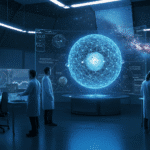When Innovation Turns to Catastrophe: The Unintended Consequences of Breakthrough Inventions
The Dual Edge of Innovation
Innovation drives progress and improves our lives, yet history is riddled with breakthroughs that spiraled into disasters. This phenomenon, where good intentions meet unforeseen consequences, presents a compelling narrative in the annals of scientific advancement. Understanding the unintended ramifications of innovations helps us grasp the complexities of modern society.
The Birth of the Automobile
The invention of the automobile revolutionized transportation and spawned entire industries. However, this breakthrough also introduced devastating consequences. The proliferation of cars led to increased road fatalities, traffic congestion, and environmental pollution. Urban planning had to adjust dramatically, often prioritizing vehicles over public transport or pedestrian safety. Cities designed in the early 20th century now grapple with sprawling road networks and polluted air, prompting urgent discussions about sustainable development and green technologies.
Asbestos: The Tragic Misstep
Asbestos was once heralded as a miracle material in insulation and fireproofing. Its fibers, resistant to heat and decay, were incorporated into countless products and buildings. As the negative health effects, including lung cancer and mesothelioma, emerged, the once celebrated invention turned catastrophic. The extensive use of asbestos led to a global health crisis, resulting in strict regulations and extensive legal battles. This catastrophe underscores the importance of rigorous testing and transparent communication in product development.
Thalidomide: A Pharmaceutical Horror
Initially marketed as a sedative and remedy for morning sickness in the late 1950s, thalidomide became infamous for its association with severe birth defects. Thousands of children were born with phocomelia, leading to its ban in the early 1960s. This tragedy prompted changes in drug testing and approval processes, advocating for stronger regulatory measures in the pharmaceutical industry to prevent a recurrence of such a situation. Thalidomide’s legacy still influences today’s debate on drug safety, ethics, and the need for stringent clinical trials.
DDT: The Pest Control Paradox
Dichloro-diphenyl-trichloroethane (DDT) was hailed as a revolutionary pesticide, dramatically reducing insect-borne diseases, particularly malaria. However, its widespread use resulted in environmental degradation and severe impacts on wildlife, including the near extinction of several bird species due to eggshell thinning. The backlash against DDT led to a heightened awareness of ecological balance, ushering in environmental movements calling for sustainable agricultural practices. Ruthless exploitation of chemical solutions revealed the intricate connections between human practices and ecosystem health.
The Internet: A Double-Edged Sword
The internet has transformed society by revolutionizing communication, commerce, and access to information. Yet, it has also engendered significant unintended consequences. Cyberbullying, misinformation, and privacy violations have plagued the digital landscape. Social media platforms initially designed for connection have been misused for disinformation, manipulation, and even cyberwarfare. The challenge now lies in finding a balance between innovation and protecting societal values, encouraging discussions around digital ethics and regulatory frameworks.
Artificial Intelligence: The Ominous Outlook
Artificial intelligence (AI) promises to reshape industries and improve efficiency. However, the rise of AI brings forth ethical dilemmas and potential job displacement. Systems trained on biased data can perpetuate discrimination, leading to unfair outcomes in hiring, law enforcement, and lending. As AI continues evolving, debates about accountability and moral responsibility grow increasingly pertinent. The balance between leveraging AI for advancement while ensuring ethical considerations are applied is vital as we navigate its deployment across various sectors.
The Green Revolution’s Complications
The Green Revolution significantly increased food production, alleviating hunger in many parts of the world. However, the reliance on chemical fertilizers and pesticides resulted in soil degradation, loss of biodiversity, and water supply issues. Farmers faced economic pressures due to monoculture practices, leading to social disparities within agricultural communities. The need for sustainable agricultural practices is now more critical than ever, prompting innovation in organic farming and biotechnology.
The Consequences of Social Media
Social media platforms, while transformative, have engendered serious social implications. They have altered interpersonal communications, often fostering superficial interactions rather than meaningful relationships. The proliferation of “echo chambers” and polarized viewpoints can destabilize public discourse. Moreover, mental health issues, particularly among younger demographics, have risen in tandem with social media use, prompting calls for societal introspection regarding its usage and impact on individual well-being.
Genetic Engineering: Ethical Crossroads
CRISPR and other genetic engineering technologies hold the promise of eradicating genetic disorders. However, the ethical implications are vast and troubling. The possibility of “designer babies” raises questions about eugenics and socio-economic disparities. Unintended genetic consequences could emerge as we alter the building blocks of life, creating further ethical dilemmas in how we regulate and manage genetic information.
The Mirage of Contraceptive Methods
Various contraceptive methods are designed to empower reproductive freedom and health. However, numerous side effects, unintended pregnancies, and disparities in access have emerged, often influenced by socio-economic factors. The complexities surrounding contraceptives further indicate the need for comprehensive education and equitable healthcare solutions, ensuring informed choices and health equity.
The Dangers of Bioengineering
While bioengineering offers potential advancements in medicine and agriculture, unforeseen consequences loom large. Genetically modified organisms (GMOs) aim to create crops resistant to pests and diseases, yet they risk disrupting local ecosystems and diminishing genetic biodiversity. Idea behind solving hunger issues can backfire, leading to food insecurity or resistance in pest populations, prompting bioethical debates on the sustainability and safety of such technologies.
Nuclear Energy: A Double-Edged Sword
The advent of nuclear energy was groundbreaking in providing a powerful, low-carbon energy source. However, disasters like Chernobyl and Fukushima highlighted the catastrophic risks involved. The long-term environmental and health impacts of radiation continue to challenge the nuclear industry. The inherent dangers associated with its use have reignited the debate over energy alternatives, pushing for a focus on renewables and necessitating stringent safety regulations to mitigate catastrophic failures.
Conclusion
The tension between innovation and its unintended consequences persists across time and technology. Breakthroughs that promise immense benefits can lead to catastrophic failures if ethical considerations, environmental concerns, and societal impacts remain unaddressed. As society progresses, there exists an imperative to remain vigilant, learning from historical lessons to innovate responsibly, ensuring that the inventions born of necessity do not turn into harbingers of disaster.



